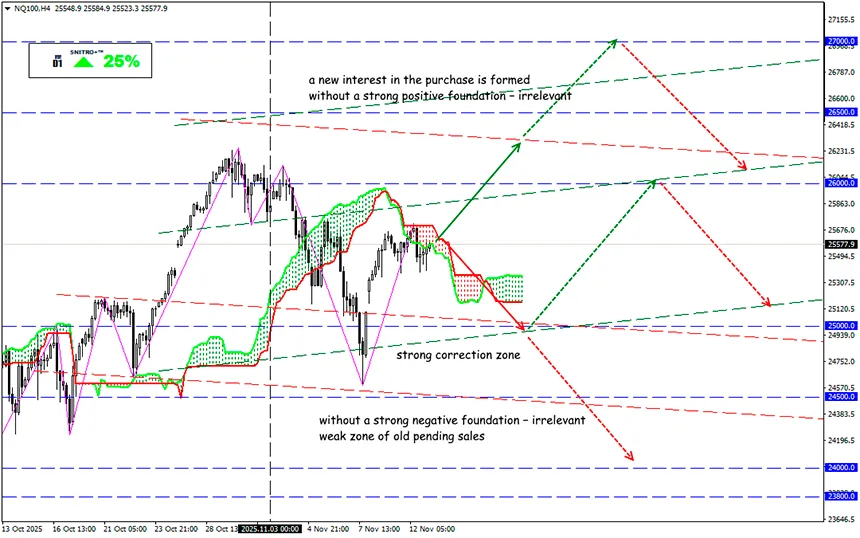How to Survive After the AI Bubble Crash

Why Artificial Intelligence Is Dangerous for the Stock Market
NQ100
Key zone: 25,400-25,700
Buy: 25,700(after retesting the 25,600 level); target 25,900-29,950; StopLoss 25,600
Sell: 25,350(on strong negative fundamentals); target 25,150-25,100; StopLoss 25,450
AI chips have effectively become a new class of financial assets. The danger of the AI bubble lies in the fact that the market capitalization of artificial-intelligence companies has become disconnected from their real financial performance and the fundamental value of their businesses.
AI is turning into a new speculative mania, and the clearest barometer of AI-risk is the surge in Nvidia stock.
The price of the company’s AI processors already reaches tens of thousands of dollars, while total BigTech investments in this sector in 2025 will amount to about $400 billion, with forecasts up to $3 trillion by 2029.
- The success of leaders such as NVIDIA creates a domino effect: even unprofitable companies gain billions in market cap simply because they have the word AI in their name.
- Funds and index products automatically buy such stocks, amplifying the overvaluation.
- Classic valuation multiples (P/E, P/S) are returning to levels last seen during the dot-com bubble of 1999–2000.
The danger of an AI flash crash is not limited to the mispricing of companies or earnings. AI investors have forgotten how destructive asset depreciation can be.
- Unlike industrial equipment or infrastructure, AI chips are short-lived assets with a lifespan of 2–5 years.
- Capital expenditures on AI assets are recurring, not one-time: to remain competitive, chip and software upgrades must be constant — this destroys their investment value.
- Electricity-supply constraints slow the construction of data centers, making the use of older chips economically meaningless.
- Private credit funds increasingly use AI processors as collateral — Microsoft alone has issued more than $60 billion in such loans to risky startups.
- The market for leasing and buying chips on borrowed funds is growing, including for OpenAI and Elon Musk’s xAI.
- The residual value of AI assets depends on many poorly predictable factors, such as technological change, new-chip production, access to critical materials, or export bans.
It is no coincidence that Michael Burry, who made his fortune on the 2008 crisis, has opened a major short position against AI stocks.
What happens next?
The AI industry is turning into an arms race where capital burns faster than it can generate profit.
When expectations fail to materialize, investors exit positions en masse, collapsing even the strongest stocks.
In past crises the Fed saved the banks, but in the new financial architecture the banking sector may no longer be the main problem. Regulators may have to rescue the AI infrastructure, on which the functioning of the entire financial system depends.
Sam Altman is already proposing that the government insure AI infrastructure for $1 trillion, despite the fact that current capacities are already morally outdated. It is not impossible that the Fed will have to buy AI-company shares, and the U.S. government will acquire stakes in key market players, while smaller companies simply disappear.
Intelligence is trying to protest against the hype: there is still time to use your own mind before an artificial one starts making decisions for you. Hedge risks, avoid following the crowd, and never invest without full multi-factor analysis.
The AI market can survive a collapse – but only those who understand the difference between technology and speculation will survive within it.
And in the next material, we will explain how exactly to select AI companies with real value.
So we act wisely and avoid unnecessary risks.
Profits to y’all!








